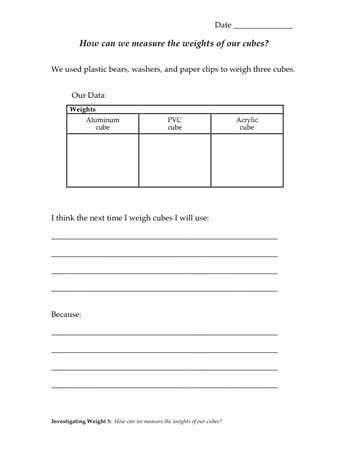How can we measure the weights of our cubes?
Plan Investigating Weight 3
Students have established the weight order of the cubes by using a pan balance to compare them with one another, but they don’t yet know what the cubes weigh. Nor do they know how much more one cube weighs than another. In this investigation, they find out — but in an unconventional way.
Students use the pan balance to weigh three of the cubes using paper clips, steel washers, and plastic bears as their units of measurement. They may use these nonstandard units separately or in combination. Either way, by the end of the investigation, students will appreciate the usefulness of a single measure for weight.
Learning Goals
- to see the importance of using a rational and shared system for measuring weight
| Sequence of experiences | ||
|---|---|---|
| 1. Ask the question | All Class | 15 Mins |
| 2. Weigh three cubes | Small Groups | 15 Mins |
| 3. Make meaning | All Class | 15 Mins |
Materials and Preparation
For the class:- Post the investigation question in a place where all students can see it.
- Make a class table on a whiteboard or flip chart for recording the weights of three cubes; an example is shown in Step 3.
- Approximately 50 grams of plastic modeling clay (for use in a demonstration)
- 1 aluminum, 1 pine, 1 oak, and 1 copper cube
- 1 pan balance
- 1 aluminum, 1 PVC, and 1 acrylic cube
- A container with a mixture of at least 25 plastic counting bears, 40 steel washers, and 85 large paper clips
- 2 pan balances





